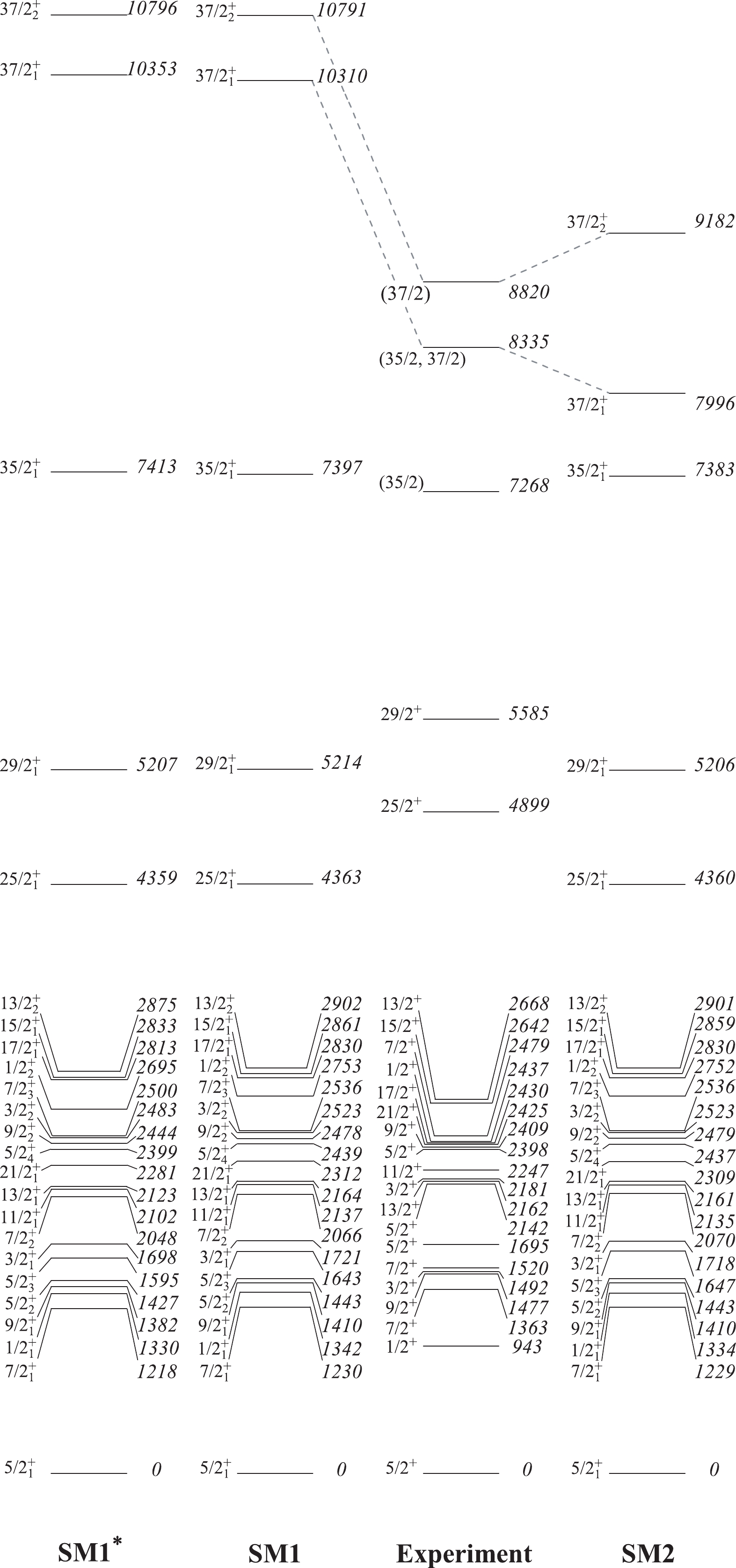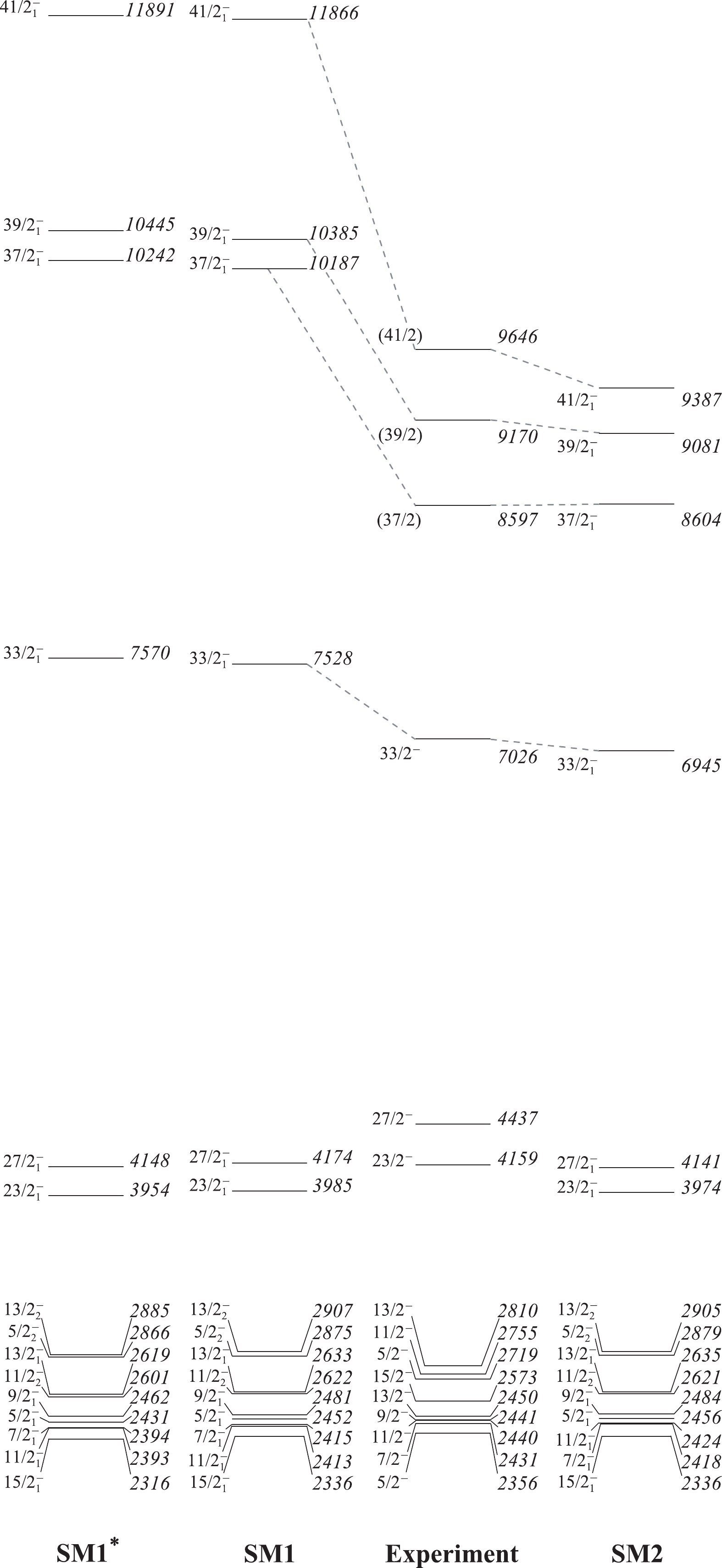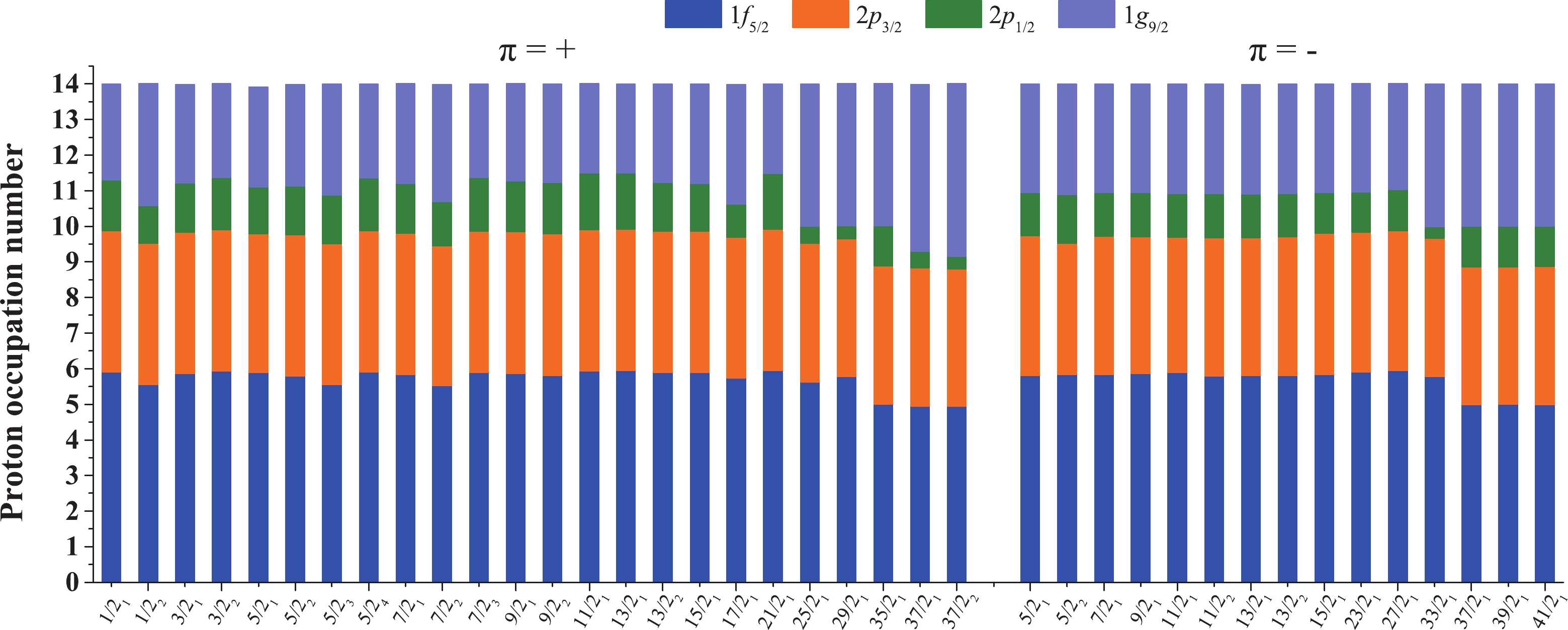HTML
--> --> -->The previous theoretical studies on the
 Figure1. Comparison of the experimental and calculated energy levels of the positive-parity states in
Figure1. Comparison of the experimental and calculated energy levels of the positive-parity states in  Figure2. Comparison of the experimental and calculated energy levels of the negative-parity states in
Figure2. Comparison of the experimental and calculated energy levels of the negative-parity states in SM2 used the same proton configuration space as SM1, and on the basis of the neutron configuration space of SM1, in SM2, excitation of the valence neutron across the N = 56 subshell closure into the higher-lying
  |   | SM1 | SM2 | |||||
  | wave function   | partitions (%) |   | wave function   | partitions (%) | |||
  | 943 | 1342 | 6 4 2 2   | 64.51 | 1334 | 6 4 2 2   | 64.21 | |
6 4 0 4   | 25.30 | 6 4 0 4   | 25.44 | |||||
  | 2437 | 2753 | 6 4 0 4   | 41.80 | 2752 | 6 4 0 4   | 41.73 | |
6 4 2 2   | 27.70 | 6 4 2 2   | 27.90 | |||||
  | 1492 | 1721 | 6 4 2 2   | 59.79 | 1718 | 6 4 2 2   | 59.55 | |
6 4 0 4   | 26.50 | 6 4 0 4   | 26.53 | |||||
  | 2181 | 2523 | 6 4 2 2   | 67.84 | 2523 | 6 4 2 2   | 67.63 | |
6 4 0 4   | 23.35 | 6 4 0 4   | 23.38 | |||||
  | 0 | 0 | 6 4 2 2   | 59.01 | 0 | 6 4 2 2   | 58.92 | |
6 4 0 4   | 30.26 | 6 4 0 4   | 30.25 | |||||
  | 1695 | 1443 | 6 4 2 2   | 55.40 | 1443 | 6 4 2 2   | 55.33 | |
6 4 0 4   | 24.87 | 6 4 0 4   | 24.95 | |||||
  | 2142 | 1643 | 6 4 2 2   | 43.21 | 1647 | 6 4 2 2   | 42.84 | |
6 4 0 4   | 24.43 | 6 4 0 4   | 25.23 | |||||
  | 2398 | 2439 | 6 4 2 2   | 66.75 | 2437 | 6 4 2 2   | 66.23 | |
6 4 0 4   | 22.22 | 6 4 0 4   | 22.46 | |||||
  | 1363 | 1230 | 6 4 2 2   | 58.13 | 1229 | 6 4 2 2   | 58.14 | |
6 4 0 4   | 25.41 | 6 4 0 4   | 24.48 | |||||
  | 1520 | 2066 | 6 4 2 2   | 34.76 | 2070 | 6 4 2 2   | 34.45 | |
6 4 0 4   | 23.88 | 6 4 0 4   | 24.00 | |||||
  | 2479 | 2536 | 6 4 2 2   | 68.22 | 2536 | 6 4 2 2   | 67.93 | |
6 4 0 4   | 20.72 | 6 4 0 4   | 20.82 | |||||
  | 1477 | 1410 | 6 4 2 2   | 61.43 | 1410 | 6 4 2 2   | 61.37 | |
6 4 0 4   | 25.11 | 6 4 0 4   | 25.09 | |||||
  | 2409 | 2478 | 6 4 2 2   | 61.41 | 2479 | 6 4 2 2   | 60.86 | |
6 4 0 4   | 22.19 | 6 4 0 4   | 22.32 | |||||
  | 2247 | 2137 | 6 4 2 2   | 73.06 | 2135 | 6 4 2 2   | 72.95 | |
6 4 0 4   | 17.41 | 6 4 0 4   | 17.40 | |||||
  | 2162 | 2164 | 6 4 2 2   | 72.85 | 2161 | 6 4 2 2   | 72.54 | |
6 4 0 4   | 18.62 | 6 4 0 4   | 18.70 | |||||
  | 2668 | 2902 | 6 4 2 2   | 60.38 | 2901 | 6 4 2 2   | 59.55 | |
6 4 0 4   | 27.87 | 6 4 0 4   | 28.23 | |||||
  | 2642 | 2861 | 6 4 2 2   | 59.21 | 2859 | 6 4 2 2   | 59.06 | |
6 4 0 4   | 29.04 | 6 4 0 4   | 29.08 | |||||
  | 2430 | 2830 | 6 4 2 2   | 30.95 | 2830 | 6 4 2 2   | 30.95 | |
6 4 0 4   | 25.51 | 6 4 0 4   | 25.28 | |||||
  | 2425 | 2312 | 6 4 2 2   | 73.32 | 2309 | 6 4 2 2   | 73.09 | |
6 4 0 4   | 19.51 | 6 4 0 4   | 19.52 | |||||
| Continued on next page | ||||||||
Table1.Main partitions of the wave functions for
The
| Table 2-continued from previous page | ||||||||
  |   | SM1 | SM2 | |||||
  | wave function   | partitions (%) |   | wave function   | partitions (%) | |||
  | 4899 | 4363 | 6 4 0 4   | 62.57 | 4360 | 6 4 0 4   | 62.48 | |
4 4 2 4   | 10.68 | 4 4 2 4   | 10.57 | |||||
  | 5585 | 5214 | 6 4 0 4   | 71.07 | 5206 | 6 4 0 4   | 70.42 | |
6 3 1 4   | 11.26 | 6 3 1 4   | 11.14 | |||||
  | 7268 | 7397 | 5 4 1 4   | 85.75 | 7383 | 5 4 1 4   | 83.91 | |
5 3 2 4   | 10.96 | 5 3 2 4   | 10.87 | |||||
  | 8335 | 10310 | 4 4 2 4   | 78.55 | 7996 | 5 4 0 5   | 65.81 | |
5 3 2 4   | 8.47 | 5 4 2 3   | 14.37 | |||||
  | 8820 | 10791 | 5 4 1 4   | 76.21 | 9182 | 5 4 0 5   | 69.97 | |
5 3 2 4   | 9.16 | 5 3 1 5   | 11.49 | |||||
  | 2356 | 2452 | 6 4 1 3   | 72.02 | 2456 | 6 4 1 3   | 71.95 | |
5 4 2 3   | 12.87 | 5 4 2 3   | 12.87 | |||||
  | 2719 | 2875 | 6 4 1 3   | 50.68 | 2879 | 6 4 1 3   | 50.93 | |
5 4 2 3   | 10.28 | 6 3 2 3   | 25.89 | |||||
  | 2431 | 2415 | 6 4 1 3   | 71.48 | 2418 | 6 4 1 3   | 71.49 | |
5 4 2 3   | 10.02 | 5 4 2 3   | 10.00 | |||||
  | 2441 | 2481 | 6 4 1 3   | 69.97 | 2484 | 6 4 1 3   | 69.73 | |
6 3 2 3   | 12.49 | 6 3 2 3   | 12.57 | |||||
  | 2440 | 2413 | 6 4 1 3   | 71.09 | 2424 | 6 4 1 3   | 66.13 | |
6 3 2 3   | 14.41 | 6 3 2 3   | 15.77 | |||||
  | 2755 | 2622 | 6 4 1 3   | 65.96 | 2621 | 6 4 1 3   | 63.21 | |
5 4 2 3   | 14.22 | 5 4 2 3   | 10.78 | |||||
  | 2450 | 2633 | 6 4 1 3   | 67.04 | 2635 | 6 4 1 3   | 66.92 | |
5 4 2 3   | 11.98 | 5 4 2 3   | 12.02 | |||||
  | 2810 | 2907 | 6 4 1 3   | 69.76 | 2905 | 6 4 1 3   | 69.83 | |
5 4 2 3   | 12.76 | 5 4 2 3   | 11.92 | |||||
  | 2573 | 2336 | 6 4 1 3   | 79.49 | 2336 | 6 4 1 3   | 75.01 | |
5 4 2 3   | 10.42 | 5 4 2 3   | 10.36 | |||||
  | 4159 | 3985 | 6 4 1 3   | 83.76 | 3974 | 6 4 1 3   | 82.46 | |
5 4 2 3   | 5.26 | 5 4 2 3   | 4.95 | |||||
  | 4437 | 4174 | 6 4 1 3   | 87.89 | 4141 | 6 4 1 3   | 68.96 | |
6 3 2 3   | 4.56 | 6 4 2 2   | 13.41 | |||||
  | 7026 | 7528 | 5 4 0 5   | 74.01 | 6945 | 6 4 0 4   | 72.95 | |
5 3 1 5   | 13.57 | 6 3 1 4   | 8.96 | |||||
  | 8597 | 10187 | 4 4 1 5   | 77.63 | 8604 | 5 4 1 4   | 78.94 | |
4 3 2 5   | 14.28 | 5 3 2 4   | 10.54 | |||||
  | 9170 | 10385 | 4 4 1 5   | 80.41 | 9081 | 5 4 1 4   | 83.79 | |
4 3 2 5   | 10.70 | 5 3 2 4   | 12.24 | |||||
  | 9646 | 11866 | 5 4 2 3   | 48.24 | 9387 | 5 4 1 4   | 84.79 | |
5 4 0 5   | 39.44 | 5 3 2 4   | 11.11 | |||||
A similar situation appears in the negative parity states of
Based on the two sets of shell model calculations, the 41/2
The lower negative parity states with spin
In order to more intuitively understand the contribution of different orbitals to each state, we also calculated the occupation numbers for protons and neutrons based on the configuration space of SM2. The calculated occupation numbers for protons and neutrons are shown in Figs. 3 and 4, respectively. It can be seen from Fig. 3 that a large contribution to both kinds of parity states (I
 Figure3. (color online) Calculated occupation numbers of the 1
Figure3. (color online) Calculated occupation numbers of the 1 Figure4. (color online) Calculated occupation numbers of the 1
Figure4. (color online) Calculated occupation numbers of the 1





